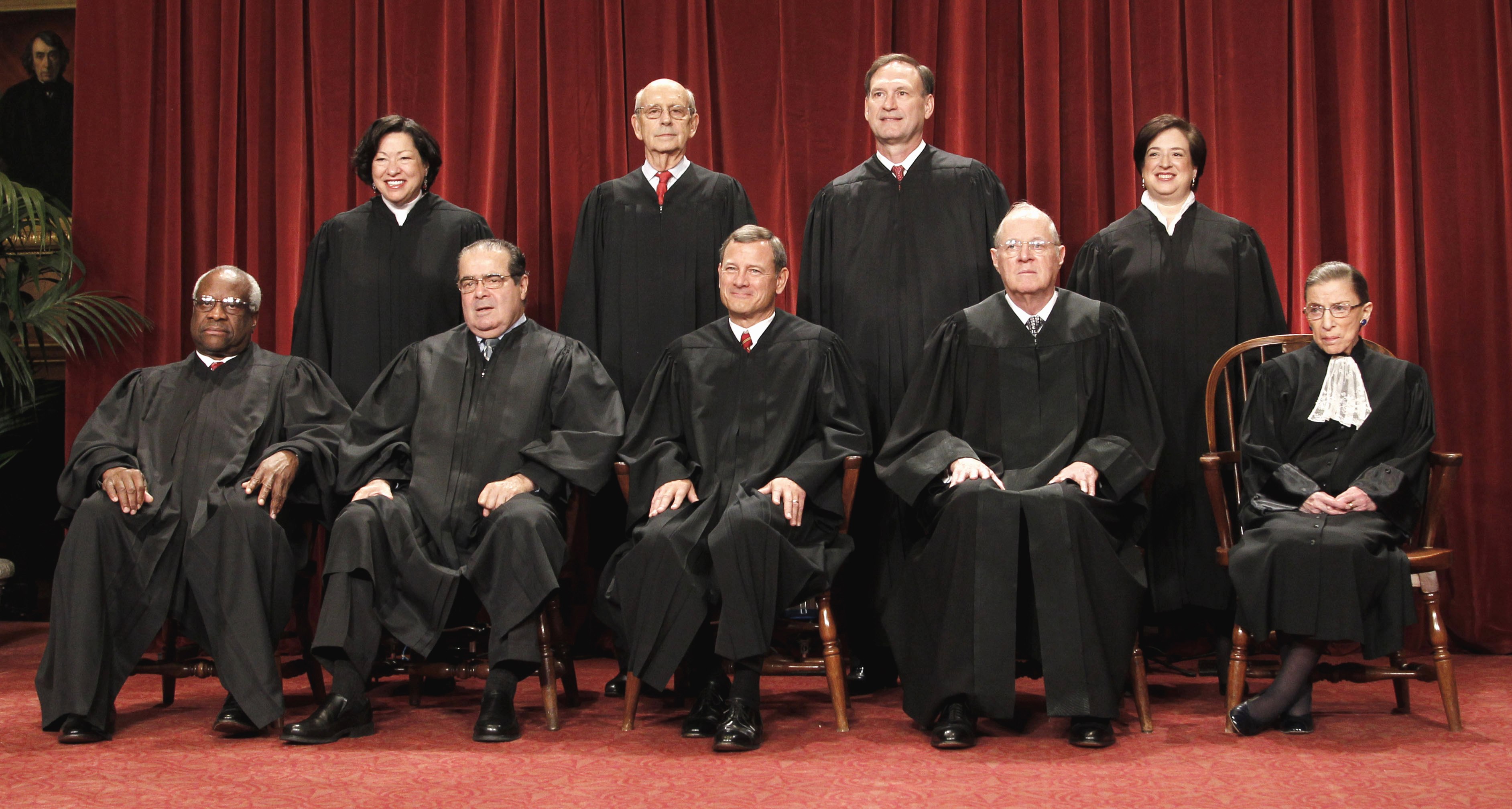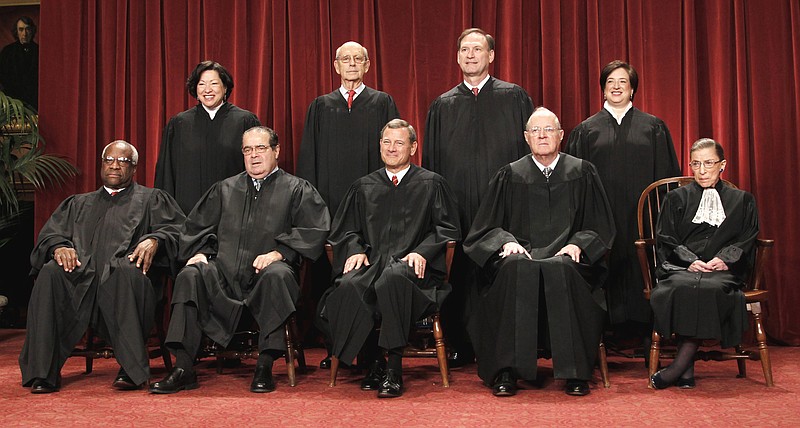 This Oct. 8, 2010 file photo shows the justices of the U.S. Supreme Court at the Supreme Court in Washington. Seated from left are Associate Justices Clarence Thomas, and Antonin Scalia, Chief Justice John Roberts, Associate Justices Anthony M. Kennedy and Ruth Bader Ginsburg. Standing, from left are Associate Justices Sonia Sotomayor, Stephen Breyer, Samuel Alito Jr., and Elena Kagan. The Supreme Court today upheld the individual insurance requirement at the heart of President Barack Obama's historic health care overhaul. (AP Photo/Pablo Martinez Monsivais, File)
This Oct. 8, 2010 file photo shows the justices of the U.S. Supreme Court at the Supreme Court in Washington. Seated from left are Associate Justices Clarence Thomas, and Antonin Scalia, Chief Justice John Roberts, Associate Justices Anthony M. Kennedy and Ruth Bader Ginsburg. Standing, from left are Associate Justices Sonia Sotomayor, Stephen Breyer, Samuel Alito Jr., and Elena Kagan. The Supreme Court today upheld the individual insurance requirement at the heart of President Barack Obama's historic health care overhaul. (AP Photo/Pablo Martinez Monsivais, File)By CONNIE CASS
WASHINGTON (AP) - The Supreme Court's decision to uphold President Barack Obama's health care law follows a century of debate over what role the government should play in helping people in the United States afford medical care. A look at the issue through the years:
1912: Former President Theodore Roosevelt champions national health insurance as he unsuccessfully tries to ride his progressive Bull Moose Party back to the White House.
1929: Baylor Hospital in Texas originates group health insurance. Dallas teachers pay 50 cents a month to cover up to 21 days of hospital care per year.
1935: President Franklin D. Roosevelt favors creating national health insurance amid the Great Depression but decides to push for Social Security first.
1942: Roosevelt establishes wage and price controls during World War II. Businesses can't attract workers with higher pay so they compete through added benefits, including health insurance, which grows into a workplace perk.
1945: President Harry Truman calls on Congress to create a national insurance program for those who pay voluntary fees. The American Medical Association denounces the idea as "socialized medicine" and it goes nowhere.
1960: John F. Kennedy makes health care a major campaign issue but as president can't get a plan for the elderly through Congress.
1965: President Lyndon B. Johnson's legendary arm-twisting and a Congress dominated by his fellow Democrats lead to creation of two landmark government health programs: Medicare for the elderly and Medicaid for the poor.
1974: President Richard Nixon wants to require employers to cover their workers and create federal subsidies to help everyone else buy private insurance. The Watergate scandal intervenes.
1976: President Jimmy Carter pushes a mandatory national health plan, but economic recession helps push it aside.
1986: President Ronald Reagan signs COBRA, a requirement that employers let former workers stay on the company health plan for 18 months after leaving a job, with workers bearing the cost.
1988: Congress expands Medicare by adding a prescription drug benefit and catastrophic care coverage. It doesn't last long. Barraged by protests from older Americans upset about paying a tax to finance the additional coverage, Congress repeals the law the next year.
1993: President Bill Clinton puts first lady Hillary Rodham Clinton in charge of developing what becomes a 1,300-page plan for universal coverage. It requires businesses to cover their workers and mandates that everyone have health insurance. The plan meets Republican opposition, divides Democrats and comes under a firestorm of lobbying from businesses and the health care industry. It dies in the Senate.
1997: Clinton signs bipartisan legislation creating a state-federal program to provide coverage for millions of children in families of modest means whose incomes are too high to qualify for Medicaid.
2003: President George W. Bush persuades Congress to add prescription drug coverage to Medicare in a major expansion of the program for older people.
2008: Hillary Rodham Clinton promotes a sweeping health care plan in her bid for the Democratic presidential nomination. She loses to Obama, who has a less comprehensive plan.
2009: Obama and the Democratic-controlled Congress spend an intense year ironing out legislation to mandate that everyone have coverage or pay a fine; to require most companies to cover their workers; require insurance companies to accept all comers, regardless of any pre-existing conditions; and assist people who can't afford insurance.
2010: With no Republican support, Congress passes the measure, designed to extend health care coverage to more than 30 million uninsured people. Republican opponents scorn the law as "Obamacare."
2012: The Supreme Court, in a 5-4 ruling, upholds the law, including its much-disputed mandate that almost all people in the U.S. have health coverage or pay a fine. The law's ultimate fate remains unclear, however, with Republican presidential nominee Mitt Romney and GOP lawmakers promising to repeal it if they carry the November elections.
